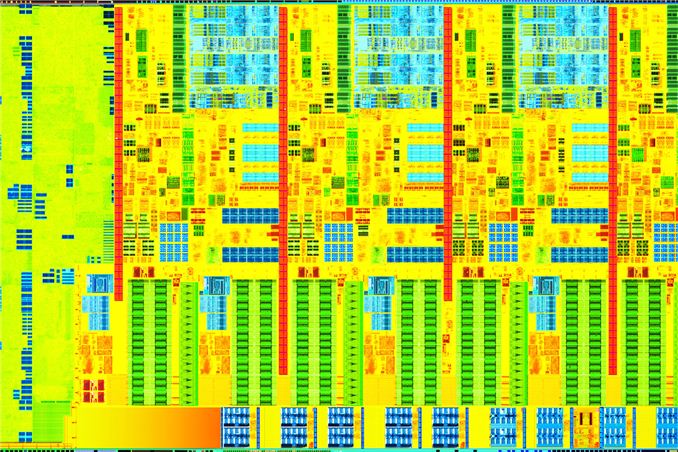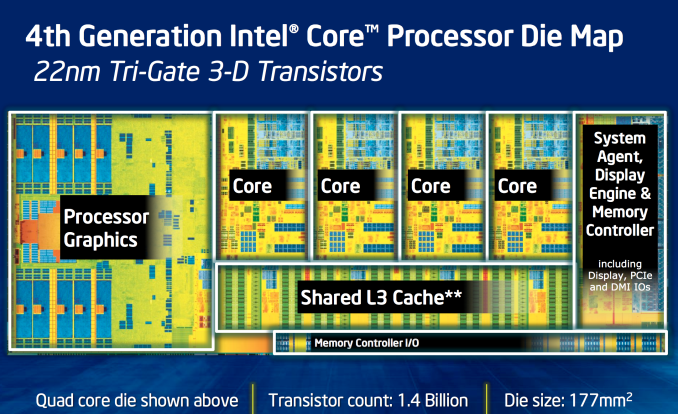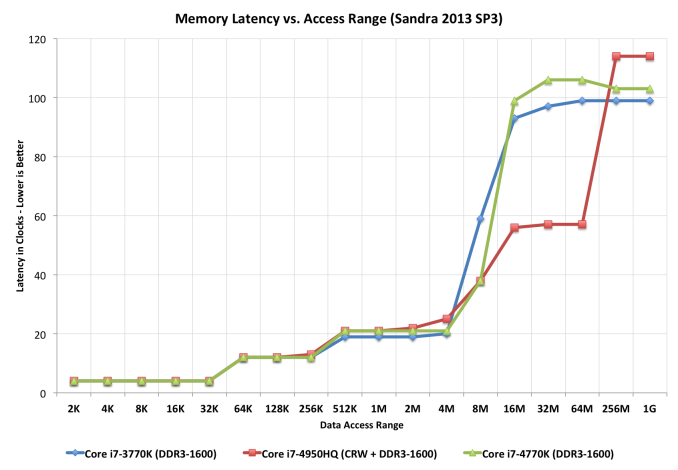The Haswell Review: Intel Core i7-4770K & i5-4670K Tested
by Anand Lal Shimpi on June 1, 2013 10:00 AM EST
This is a very volatile time for Intel. In an ARM-less vacuum, Intel’s Haswell architecture would likely be the most amazing thing to happen to the tech industry in years. In mobile Haswell is slated to bring about the single largest improvement in battery life in Intel history. In graphics, Haswell completely redefines the expectations for processor graphics. There are even some versions that come with an on-package 128MB L4 cache. And on the desktop, Haswell is the epitome of polish and evolution of the Core microprocessor architecture. Everything is better, faster and more efficient.
There’s very little to complain about with Haswell. Sure, the days of insane overclocks without touching voltage knobs are long gone. With any mobile-first, power optimized architecture, any excess frequency at default voltages is viewed as wasted power. So Haswell won’t overclock any better than Ivy Bridge, at least without exotic cooling.
You could also complain that, for a tock, the CPU performance gains aren’t large enough. Intel promised 5 - 15% gains over Ivy Bridge at the same frequencies, and most of my tests agree with that. It’s still forward progress, without substantial increases in power consumption, but it’s not revolutionary. We compare the rest of the industry to Intel’s excellent single threaded performance and generally come away disappointed. The downside to being on the top is that virtually all improvements appear incremental.
The fact of the matter is that the most exciting implementations of Haswell exist outside of the desktop parts. Big gains in battery life, power consumption and even a broadening of the types of form factors the Core family of processors will fit into all apply elsewhere. Over the coming weeks and months we’ll be seeing lots of that, but today, at least in this article, the focus is on the desktop.
Haswell CPU Architecture Recap
Haswell is Intel’s second 22nm microprocessor architecture, a tock in Intel’s nomenclature. I went through a deep dive on Haswell’s Architecture late last year after IDF, but I’ll offer a brief summary here.
At the front end of the pipeline, Haswell improved branch prediction. It’s the execution engine where Intel spent most of its time however. Intel significantly increased the sizes of buffers and datastructures within the CPU core. The out-of-order window grew, to feed an even more parallel set of execution resources.
Intel added two new execution ports (8 vs 6), a first since the introduction of the Core microarchitecture back in 2006.
On the ISA side, Intel added support for AVX2, which includes an FMA operation that considerably increases FP throughput of the machine. With a doubling of peak FP throughput, Intel doubled L1 cache bandwidth to feed the beast. Intel also added support for transactional memory instructions (TSX) on some Haswell SKUs.
The L3 cache is now back on its own power/frequency plane, although most of the time it seems to run in lockstep with the CPU cores. There appears to be a 2 - 3 cycle access penalty as a result of decoupling the L3 cache.


















210 Comments
View All Comments
Khato - Sunday, June 2, 2013 - link
Based on the published Haswell 4C GT2 die shot I believe that your estimates for the graphics area are quite high. It's relatively simple to derive the graphics area on 4C GT2 now that we know the total die size - should be somewhere in the vicinity of 58mm^2. Double that and you get 116mm^2 for GT3.As for the remaining 29mm^2 delta between 4C GT2 and 4C GT3 die sizes... I'd chalk that up to both inefficiencies due to going with a more square die instead of the long and skinny that's been with us since SNB and the extra logic/IOs necessary for the eDRAM L4.
Regardless, there's no question that the 174mm^2 figure for GT3 is incorrect as the 4 cores, associated L3, and system agent on the 4C GT2 die take up approximately 119mm^2, and adding 174mm^2 to that would yield a 293mm^2 die size.
Bobsama - Sunday, June 2, 2013 - link
I too am on a Core i7-950. I bought it in April 2012. If this system died and I was building anew, I'd probably do it--I'd probably grab an i7-4770K. But for $500, notta chance!LeetMiniWheat - Sunday, June 2, 2013 - link
Would have been nice to see some actual CPU-bound games, like Skyrim. Or something low res to take the load completely off the GPU.roltzje - Sunday, June 2, 2013 - link
It doesn't take a genius to figure whats going on here. Competition spurs innovation. There is no competition for mid-high end desktop processors, or even laptop processors really. AMD only keeps up with mid range because they have to set very high clocks on their inferior architecture.Where the competition is is in mobile. Smartphones and tablets. By moving Haswell down this generation, Intel is getting themselves closer to be a true competitor in that space. This year we should see a power and battery life combination that ARM cannot reach.
There are also huge gains for gaming and gaming laptops. A 14-15" mid-ranger cost $500 with Iris graphics should be able to run most games decently now without all-minimum settings. Especially given that the PS4 and XBO are running x86 low to mid range graphics, I can easily see Haswell notebooks keeping up, especially Iris pro laptops, which I would assume can come in under $1000 and in relatively slim form factors.
deepblue08 - Sunday, June 2, 2013 - link
I think they should benchmarks this new CPU with 2-3GPUs. I don't think 1 video card is enough to really test the strength of new cpus, which is why the difference between ivy bridge and haswell is so small. Give them 2-3 GPUs to work with and see if they can really step-up.Yahma - Sunday, June 2, 2013 - link
YAWN... with no competition from AMD, Haswell offers none to just a few % improvement over the previous generation (depending on who's benchmarks you believe), higher power consumption, and fewer features (ie. no virtualization extensions on the higher end models) all at a higher price that requires one to purchase a new motherboard.... No Thanks!just4U - Sunday, June 2, 2013 - link
That was covered in a previous article.. it was established that the 3770K was the go to cpu for multiple video card systems. (altho.. I'd say this would do in a pinch as would the previous 2600/2700K)Yahma - Sunday, June 2, 2013 - link
YAWN... with no competition from AMD, Haswell offers none to just a few % improvement over the previous generation (depending on who's benchmarks you believe), higher power consumption, and fewer features (ie. no virtualization extensions on the higher end models) all at a higher price that requires one to purchase a new motherboard.... No Thanks!mcbowler - Sunday, June 2, 2013 - link
thanks for posting "CPU Performance: Going Even Further Back" almost twice as fast as my i5 750. I just might upgrade when the NCASE M1 is available.araczynski - Sunday, June 2, 2013 - link
either way, should be a serious boost in power to my aging E8500 :)